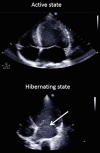Low cardiac output as physiological phenomenon in hibernating, free-ranging Scandinavian brown bears (Ursus arctos) - an observational study
- PMID: 25224464
- PMCID: PMC4245199
- DOI: 10.1186/1476-7120-12-36
Low cardiac output as physiological phenomenon in hibernating, free-ranging Scandinavian brown bears (Ursus arctos) - an observational study
Abstract
Background: Despite 5-7 months of physical inactivity during hibernation, brown bears (Ursus arctos) are able to cope with physiological conditions that would be detrimental to humans. During hibernation, the tissue metabolic demands fall to 25% of the active state. Our objective was to assess cardiac function associated with metabolic depression in the hibernating vs. active states in free-ranging Scandinavian brown bears.
Methods: We performed echocardiography on seven free-ranging brown bears in Dalarna, Sweden, anesthetized with medetomidine-zolazepam-tiletamine-ketamine during winter hibernation in February 2013 and with medetomidine-zolazepam-tiletamine during active state in June 2013. We measured cardiac output noninvasively using estimates of hemodynamics obtained by pulsed wave Doppler echocardiography and 2D imaging. Comparisons were made using paired T-tests.
Results: During hibernation, all hemodynamic indices were significantly decreased (hibernating vs. active state): mean heart rate was 26.0 (standard deviation (SD): 5.6) beats per min vs. 75.0 (SD: 17.1) per min (P=0.002), mean stroke volume 32.3 (SD: 5.2) ml vs. 47.1 (SD: 7.9) ml (P=0.008), mean cardiac output 0.86 (SD: 0.31) l/min vs. 3.54 (SD: 1.04) l/min (P=0.003), and mean cardiac index 0.63 (SD: 0.21) l/min/kg vs. 2.45 (SD: 0.52) l/min/ m2 (P<0.001). Spontaneous echo contrast was present in all cardiac chambers in all seven bears during hibernation, despite the absence of atrial arrhythmias and valvular disease.
Conclusion: Free-ranging brown bears demonstrate hemodynamics comparable to humans during active state, whereas during hibernation, we documented extremely low-flow hemodynamics. Understanding these physiological changes in bears may help to gain insight into the mechanisms of cardiogenic shock and heart failure in humans.
Figures


Similar articles
-
Cardiac adaptation in hibernating, free-ranging Scandinavian Brown Bears (Ursus arctos).Sci Rep. 2020 Jan 14;10(1):247. doi: 10.1038/s41598-019-57126-y. Sci Rep. 2020. PMID: 31937799 Free PMC article.
-
Cardiac function adaptations in hibernating grizzly bears (Ursus arctos horribilis).J Comp Physiol B. 2010 Mar;180(3):465-73. doi: 10.1007/s00360-009-0421-x. Epub 2009 Nov 26. J Comp Physiol B. 2010. PMID: 19940994
-
Capture, anesthesia, and disturbance of free-ranging brown bears (Ursus arctos) during hibernation.PLoS One. 2012;7(7):e40520. doi: 10.1371/journal.pone.0040520. Epub 2012 Jul 16. PLoS One. 2012. PMID: 22815757 Free PMC article.
-
Cardiovascular function in large to small hibernators: bears to ground squirrels.J Comp Physiol B. 2015 Apr;185(3):265-79. doi: 10.1007/s00360-014-0881-5. Epub 2014 Dec 27. J Comp Physiol B. 2015. PMID: 25542162 Review.
-
Insights from the Den: How Hibernating Bears May Help Us Understand and Treat Human Disease.Clin Transl Sci. 2015 Oct;8(5):601-5. doi: 10.1111/cts.12279. Epub 2015 Jun 17. Clin Transl Sci. 2015. PMID: 26083277 Free PMC article. Review.
Cited by
-
Antipsychotic inductors of brain hypothermia and torpor-like states: perspectives of application.Psychopharmacology (Berl). 2017 Jan;234(2):173-184. doi: 10.1007/s00213-016-4496-2. Epub 2016 Dec 8. Psychopharmacology (Berl). 2017. PMID: 27933367 Review.
-
Seasonal variation in haematological and biochemical variables in free-ranging subadult brown bears (Ursus arctos) in Sweden.BMC Vet Res. 2015 Dec 8;11:301. doi: 10.1186/s12917-015-0615-2. BMC Vet Res. 2015. PMID: 26646442 Free PMC article.
-
Denning in brown bears.Ecol Evol. 2020 May 25;10(13):6844-6862. doi: 10.1002/ece3.6372. eCollection 2020 Jul. Ecol Evol. 2020. PMID: 32724555 Free PMC article. Review.
-
Cardiomyocyte Protection by Hibernating Brown Bear Serum: Toward the Identification of New Protective Molecules Against Myocardial Infarction.Front Cardiovasc Med. 2021 Jul 16;8:687501. doi: 10.3389/fcvm.2021.687501. eCollection 2021. Front Cardiovasc Med. 2021. PMID: 34336951 Free PMC article.
-
Regulation of blood oxygen transport in hibernating mammals.J Comp Physiol B. 2017 Jul;187(5-6):847-856. doi: 10.1007/s00360-017-1085-6. Epub 2017 Mar 21. J Comp Physiol B. 2017. PMID: 28324160 Review.
References
-
- Fink T, Rasmussen JG, Emmersen J, Pilgaard L, Fahlman Å, Brunberg S, Josefsson J, Arnemo JM, Zachar V, Swenson JE, Fröbert O. Adipose-derived stem cells from the brown bear (Ursus arctos) spontaneously undergo chondrogenic and osteogenic differentiation in vitro. Stem Cell Res. 2011;7:89–95. doi: 10.1016/j.scr.2011.03.003. - DOI - PubMed
Publication types
MeSH terms
LinkOut - more resources
Full Text Sources
Other Literature Sources

